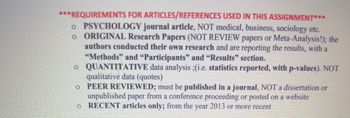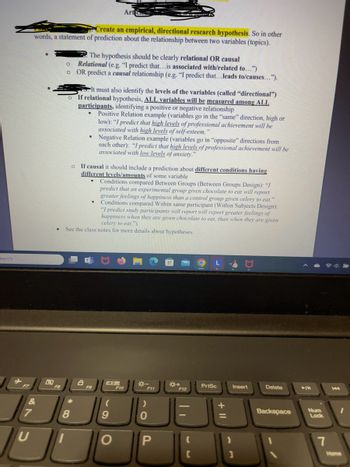
MATLAB: An Introduction with Applications
6th Edition
ISBN: 9781119256830
Author: Amos Gilat
Publisher: John Wiley & Sons Inc
expand_more
expand_more
format_list_bulleted
Question
thumb_up100%
How can answer these questions? And write

Transcribed Image Text:***REQUIREMENTS FOR ARTICLES/REFERENCES USED IN THIS ASSIGNMENT***
o PSYCHOLOGY journal article, NOT medical, business, sociology etc.
。 ORIGINAL Research Papers (NOT REVIEW papers or Meta-Analysis!); the
authors conducted their own research and are reporting the results, with a
"Methods" and "Participants" and "Results" section.
。 QUANTITATIVE data analysis ;(i.e. statistics reported, with p-values). NOT
qualitative data (quotes)
0 PEER REVIEWED; must be published in a journal, NOT a dissertation or
unpublished paper from a conference proceeding or posted on a website
。 RECENT articles only; from the year 2013 or more recent

Transcribed Image Text:earch
Art
Create an empirical, directional research hypothesis. So in other
words, a statement of prediction about the relationship between two variables (topics).
о
The hypothesis should be clearly relational OR causal
Relational (e.g. "I predict that...is associated with/related to...")
o OR predict a causal relationship (e.g. "I predict that...leads to/causes...").
It must also identify the levels of the variables (called "directional")
If relational hypothesis, ALL variables will be measured among ALL
participants, identifying a positive or negative relationship
"
Positive Relation example (variables go in the "same" direction, high or
low): "I predict that high levels of professional achievement will be
associated with high levels of self-esteem."
Negative Relation example (variables go in "opposite" directions from
each other): "I predict that high levels of professional achievement will be
associated with low levels of anxiety."
If causal it should include a prediction about different conditions having
different levels/amounts of some variable
"
Conditions compared Between Groups (Between Groups Design): "/
predict that an experimental group given chocolate to eat will report
greater feelings of happiness than a control group given celery to eat."
Conditions compared Within same participant (Within Subjects Design):
"I predict study participants will report will report greater feelings of
happiness when they are given chocolate to eat, than when they are given
celery to eat.")
See the class notes for more details about hypotheses.
F7
&
7
U
F8
*8
8
B
F9
*-
F10
F11
(
9
0
*+
F12
L
PrtSc
Insert
Delete
+11
O
P
(
}
[
1
Backspace
Num
Lock
144
7
Home
Expert Solution
This question has been solved!
Explore an expertly crafted, step-by-step solution for a thorough understanding of key concepts.
Step by stepSolved in 2 steps

Knowledge Booster
Similar questions
arrow_back_ios
arrow_forward_ios
Recommended textbooks for you
 MATLAB: An Introduction with ApplicationsStatisticsISBN:9781119256830Author:Amos GilatPublisher:John Wiley & Sons Inc
MATLAB: An Introduction with ApplicationsStatisticsISBN:9781119256830Author:Amos GilatPublisher:John Wiley & Sons Inc Probability and Statistics for Engineering and th...StatisticsISBN:9781305251809Author:Jay L. DevorePublisher:Cengage Learning
Probability and Statistics for Engineering and th...StatisticsISBN:9781305251809Author:Jay L. DevorePublisher:Cengage Learning Statistics for The Behavioral Sciences (MindTap C...StatisticsISBN:9781305504912Author:Frederick J Gravetter, Larry B. WallnauPublisher:Cengage Learning
Statistics for The Behavioral Sciences (MindTap C...StatisticsISBN:9781305504912Author:Frederick J Gravetter, Larry B. WallnauPublisher:Cengage Learning Elementary Statistics: Picturing the World (7th E...StatisticsISBN:9780134683416Author:Ron Larson, Betsy FarberPublisher:PEARSON
Elementary Statistics: Picturing the World (7th E...StatisticsISBN:9780134683416Author:Ron Larson, Betsy FarberPublisher:PEARSON The Basic Practice of StatisticsStatisticsISBN:9781319042578Author:David S. Moore, William I. Notz, Michael A. FlignerPublisher:W. H. Freeman
The Basic Practice of StatisticsStatisticsISBN:9781319042578Author:David S. Moore, William I. Notz, Michael A. FlignerPublisher:W. H. Freeman Introduction to the Practice of StatisticsStatisticsISBN:9781319013387Author:David S. Moore, George P. McCabe, Bruce A. CraigPublisher:W. H. Freeman
Introduction to the Practice of StatisticsStatisticsISBN:9781319013387Author:David S. Moore, George P. McCabe, Bruce A. CraigPublisher:W. H. Freeman

MATLAB: An Introduction with Applications
Statistics
ISBN:9781119256830
Author:Amos Gilat
Publisher:John Wiley & Sons Inc

Probability and Statistics for Engineering and th...
Statistics
ISBN:9781305251809
Author:Jay L. Devore
Publisher:Cengage Learning

Statistics for The Behavioral Sciences (MindTap C...
Statistics
ISBN:9781305504912
Author:Frederick J Gravetter, Larry B. Wallnau
Publisher:Cengage Learning

Elementary Statistics: Picturing the World (7th E...
Statistics
ISBN:9780134683416
Author:Ron Larson, Betsy Farber
Publisher:PEARSON

The Basic Practice of Statistics
Statistics
ISBN:9781319042578
Author:David S. Moore, William I. Notz, Michael A. Fligner
Publisher:W. H. Freeman

Introduction to the Practice of Statistics
Statistics
ISBN:9781319013387
Author:David S. Moore, George P. McCabe, Bruce A. Craig
Publisher:W. H. Freeman